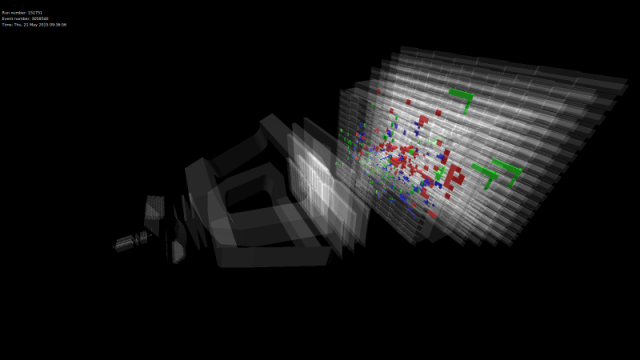Image of the day: Record setting 13 trillion electron-volt collision at the LHC
In search of dark matter, a proton-to-proton collision at the Large Hadron Collider

In the latest particle collision since the reactivation of Large Hardon Collider at CERN, the European Organization for Nuclear Research, a record-setting 13 trillion electron-volts (TeV) of energy was released when protons collided with protons in underground depths where the massive 17-mile in circumference machine is located. And so far, we’re still alive; no black hole has occurred (yet), but we do have these nifty images of the collision itself that CERN released in its commemoration.

As I write, CERN is in the midst of preparing for its next bout of tests set to take place later today, before engaging in the month long process of prepping the LHC for actual experimentation involving the detectors ALICE, ATLAS, CMS, and LHCb to begin. The higher the energy levels involved in the collisions, the smaller beams’ focus must be in order for the particles to properly collide. You can think of “energy level” as acceleration; the faster the acceleration, the smaller the beams, thus additional amount of calibration is needed to detect the resultant collisions.

“When we start to bring the beams into collision at a new energy, they often miss each other,” said LHC Operations team member Jorg Wenninger in a statement. “The beams are tiny – only about 20 microns in diameter at 6.5 TeV; more than 10 times smaller than at 450 GeV. So we have to scan around – adjusting the orbit of each beam until collision rates provided by the experiments tell us that they are colliding properly.”
Once the optimal condition is met that lets the beams interact in such a way as to produce the highest number of datum, the operations team must position the collimators around the beam orbits to intercept any stray particles.
“A key part of the process was the set-up of the collimators,” state CERN spokesperson Cian O’Luanaigh in a differing statement. “These devices which absorb stray particles were adjusted in colliding-beam conditions. This set-up will give the accelerator team the data they need to ensure that the LHC magnets and detectors are fully protected.”
Once all these steps are in order, the actual experimenting will begin. This time around, CERN is trying to determine if dark matter originates from the Higgs Boson, the elusive elementary particle of the Standard Model of particle physics that was previously detected by the LHC. The sophisticated machine will search for evidence of supersymmetry, the prediction that each particle in the Standard Model has not-yet-detected partner particle that grants the Higgs Boson its light mass.
Source: Extremetech
Learn more about Electronic Products Magazine
All contents are Copyright © by AspenCore. All Rights Reserved.
http://www.electronicproducts.com/Test_and_Measurement/Test_and_Measurement_Software/Image_of_the_day_Record_setting_13_trillion_electron_volt_collision_at_the_LHC.aspx